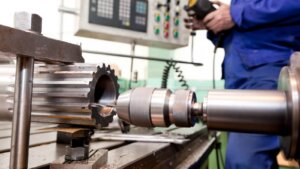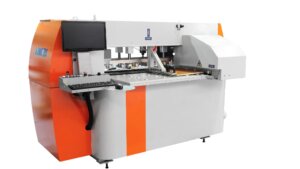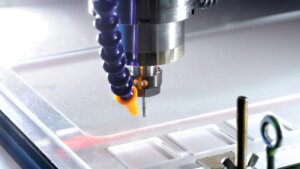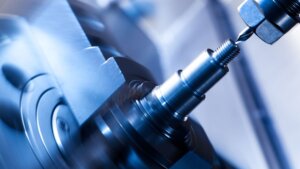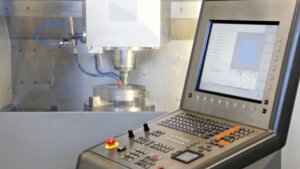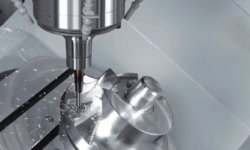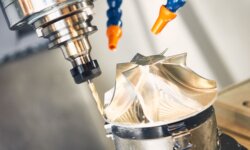In the realm of modern machining, CNC drilling stands as a cornerstone, blending precision with efficiency to revolutionize how we create.
This article delves into the essence, workings, and vast applications of CNC drilling, offering insights into its types, operations, and the machinery that powers it. Join us as we explore the intricacies of CNC drilling, shedding light on its pivotal role and how it shapes the manufacturing landscape.
What is CNC drilling?
CNC drilling is a precise CNC machining method that employs computer numerical control (CNC) where drill bits are utilized to bore holes into a material.
Unlike manual drilling, CNC drilling harnesses the power of computers to control the drill bits’ movements, ensuring accuracy and consistency that manual operations can’t match. This method is beneficial for industries requiring high precision, such as aerospace, automotive, and electronics, where even a minor discrepancy can lead to significant issues.
How Does CNC Drilling Work?
CNC drilling transforms a digital design into a tangible part through a series of programmed steps, ensuring each hole is drilled with precise specifications.
This process starts with a design and planning stage, where the concept is born and moves through various stages, each critical to the final outcome.
The journey of CNC drilling from concept to completion involves several stages, each with its unique significance:
- Design and Planning: This initial stage involves conceptualizing the product and planning the drilling requirements. It’s where ideas are converted into digital designs, using CAD (Computer-Aided Design) software. This software allows designers to create detailed 3D models, offering a blueprint for the manufacturing process.
- CAD Modeling: After the initial planning, the next step is to develop a detailed 3D model of the part to be drilled. CAD software is instrumental in this phase, enabling precise modeling of the part with all necessary specifications.
- Material Selection: Choosing the right material is crucial for the success of the drilling operation. The material must not only be suitable for the intended use of the part but also compatible with the drilling process.
- Programming: This stage involves translating the CAD model into instructions that the CNC machine can understand. CAM (Computer-Aided Manufacturing) software is used to develop these instructions, which are then converted into G-code, the language that CNC machines read.
- G-Code Generation: G-code is the final output of the programming stage, containing all the instructions for the CNC machine. This includes the movement of the drill bit, the speed of drilling, and the depth of each hole.
- Setup: Before drilling can begin, the machine needs to be set up. This involves installing the drill bit, securing the workpiece, and calibrating the machine to ensure precision.
- Drilling: The core of the process, where the machine executes the G-code to drill holes into the workpiece. This can involve various drilling cycles, depending on the requirements:
- G73 (Chip Breaking Cycle): Ideal for deep holes, preventing the accumulation of chips.
- G81 (Shallow Hole Circulation): Used for shallower holes, ensuring clean and precise drilling.
- G83 (Deep Hole Circulation): Specifically for very deep holes, incorporating a pecking motion to manage chip removal.
- Monitoring and Adjustment: Throughout the drilling process, continuous monitoring is essential to ensure everything is proceeding as planned. Adjustments may be necessary to account for any deviations.
- Post-Processing: After drilling, the workpiece often requires additional processing, such as deburring to remove any sharp edges and finishing operations to achieve the desired surface finish.
- Quality Control and Inspection: The final stage involves inspecting the drilled parts to ensure they meet the required specifications. This includes checking the dimensions, surface finish, and overall quality of the holes.
What are the Different CNC Drilling Operations?
There are 12 main CNC drilling operations that are used for different purposes. Let’s explore each type, highlighting its technical specifications and applications.
Spot Drilling
Spot drilling serves as the initial step in many CNC drilling processes, establishing a “spot” or guide for subsequent drilling operations. This operation involves creating a small indentation on the workpiece’s surface, ensuring that drill bits are accurately positioned for the main drilling operation.
Spot drilling is crucial for preventing drill bit wander and ensuring the accuracy of hole locations, making it a fundamental step in precision machining.
Drilling
At the heart of CNC drilling operations is drilling itself, the process of creating cylindrical holes in a workpiece using a rotating drill bit. This operation can be performed on various materials, including metals, plastics, and composites, with precision and speed.
Drilling is versatile, allowing for a range of hole sizes and depths, tailored to the specific requirements of each project.
Reaming
Reaming is a finishing operation used to improve the accuracy and smoothness of pre-drilled holes. By using a reamer, a tool specifically designed for this purpose, CNC machines can achieve tight tolerances and high-quality surface finishes.
Reaming is often required in applications demanding precise hole diameters and smooth internal surfaces, such as in the aerospace and automotive industries.
Boring
Boring expands upon the capabilities of drilling, enabling the enlargement of an existing hole to a specific diameter with enhanced accuracy.
This CNC drilling operation is essential for applications requiring holes of precise diameters that cannot be achieved through standard drilling processes. Boring allows for the customization of hole sizes with precision, catering to specialized manufacturing needs.
Counterboring
Counterboring creates a stepped hole, where the larger diameter is on the surface, allowing for the head of a bolt or screw to sit flush with or below the surface of the workpiece.
This operation is crucial in many assembly processes, ensuring that fasteners do not protrude undesirably from the workpiece’s surface, which is particularly important in applications where aerodynamics or aesthetics are a concern.
Countersinking
Similar to counterboring, countersinking is designed to create a conical hole that allows screw heads to sit flush with the workpiece’s surface.
Countersinking is widely used in applications requiring a smooth, flat surface, such as in the assembly of mechanical components. Countersinking enhances both the functional and aesthetic qualities of a part, ensuring seamless integration of fasteners.
Tapping
Tapping is a CNC drilling operation designed to create internal threads within a pre-drilled hole, allowing for the insertion of bolts or screws. This process requires precise control over the drill’s rotation and depth to ensure that the threads are perfectly formed for the intended fastener.
Tapping is critical in assembly processes where components need to be securely fastened together, making it a staple in manufacturing sectors such as automotive and construction.
Micro-Drilling
Micro-drilling refers to the creation of extremely small holes, often measured in micrometers, using specialized CNC machines equipped with fine drill bits.
This technique is essential for applications where precision is paramount, such as in the electronics industry for circuit board manufacturing or in medical device production. Micro-drilling allows for the formation of minute features, enabling the development of intricate components with high precision.
Center Drilling
Center drilling serves as a preparatory operation for subsequent drilling or machining processes. It involves creating a conical hole that helps guide the drill bit during deeper drilling operations, ensuring alignment and accuracy.
This is particularly important for long or complex drilling tasks where the potential for drill wander could compromise the integrity of the workpiece. Center drilling is a foundational step in achieving the high levels of precision required in industries like aerospace and machinery manufacturing.
Peck Drilling
Peck drilling is a technique used to enhance chip evacuation and coolant flow during deep hole drilling operations. By periodically retracting the drill bit, chips are broken up and removed from the hole, reducing the risk of chip clogging and heat buildup.
This method improves the drilling process’s efficiency and quality, especially in materials prone to chip packing or when drilling to significant depths. Peck drilling is indispensable in the production of components requiring deep, clean holes without thermal damage.
Gun Drilling
Gun drilling is a specialized CNC drilling operation designed for creating deep, straight holes with high precision. Originating from the manufacture of gun barrels, this technique utilizes a long, thin drill bit with internal coolant channels to maintain accuracy and surface finish over extended depths.
Gun drilling is crucial in applications requiring precise deep holes, such as hydraulic systems, aerospace components, and medical equipment.
Vibratory Drilling
Vibratory drilling, an innovative approach to CNC drilling, incorporates vibration into the drilling process to improve cutting conditions and tool life. By oscillating the drill bit at a specific frequency, material removal rates are optimized, and the likelihood of drill bit failure is reduced.
This operation is particularly effective in difficult-to-machine materials, offering enhanced productivity and quality in specialized manufacturing processes.
Now that we know about the different operations let’s get to the various components that make them possible.
What Are the Key Components of a CNC Drilling Machine?
CNC drilling machines are sophisticated systems that rely on several key components to operate with precision and efficiency. These components are crucial for the accurate execution of drilling operations, from creating simple holes to complex patterns in a variety of materials.
Let’s explore the essential components that make up a CNC drilling machine.
- Control Panel: The brain of the CNC drilling machine, the control panel operates as the interface where the operator inputs data, commands, and oversees the entire drilling process. It’s here that the designs are translated into actionable commands that guide the machine’s movements.
- Spindle: The spindle is the part of the machine that holds and rotates the drill bits. Its speed and power determine the drilling operation’s efficiency and precision, making it a critical component for achieving desired outcomes in various materials.
- Drill Bits: Drill bits are the cutting tools that actually create holes in the workpiece. Available in various sizes and materials, thnbeey are selected based on the specific requirements of the drilling task, including the type of material being drilled and the size of the hole needed.
- Worktable: This is the surface on which the workpiece is secured during drilling operations. The worktable can move in multiple axes to position the workpiece precisely under the drill bit, allowing for complex drilling patterns.
- Motor: Motors drive the spindle and are essential for determining the speed and torque of the drilling operation. The power of the motor affects the machine’s ability to drill through different materials and the overall efficiency of the drilling process.
- Tool Changer: In advanced CNC drilling machines, a tool changer allows for automatic swapping of drill bits, enabling the machine to perform multiple operations without manual intervention. This component significantly increases productivity and flexibility in drilling operations.
- Cooling System: Drilling generates a lot of heat, which can affect the quality of the workpiece and the longevity of the drill bits. The cooling system circulates coolant to reduce heat, ensuring high-quality drilling results and extending the life of the machine components.
- Chip Conveyor: Removing chips (the material removed from the workpiece) is crucial for maintaining the cleanliness of the work area and preventing damage to the machine. The chip conveyor efficiently removes chips from the drilling area, ensuring continuous operation.
What Are the Different Types of CNC Drilling Machines?
CNC drilling machines come in various configurations, each designed to meet specific needs and applications in the manufacturing industry. Understanding the technical aspects, benefits, and applications of each type can help you select the most appropriate machine for your manufacturing requirements.
Upright CNC Drill Press
The upright CNC drill press is a versatile and commonly used type of drilling machine, designed for handling a wide range of drilling tasks. Its upright configuration allows for easy accommodation of large and tall workpieces, making it suitable for various applications. These machines typically feature powerful motors and a wide range of spindle speeds, allowing them to drill through materials with different hardness and thicknesses efficiently.
- Benefits: The primary advantage of an upright CNC drill press is its versatility and capacity to handle both small and large workpieces. Its robust design and precise control system enable it to perform complex drilling patterns with high accuracy.
- Applications: Upright CNC drill presses are widely used in the metal fabrication, woodworking, and plastics industries. They are suitable for batch production, custom manufacturing, and prototype development, making them indispensable in workshops and factories.
Radial Arm CNC Drill Press
The radial arm CNC drill press features a unique design that allows the spindle to move along a radial arm, offering greater flexibility and reach than traditional upright drill presses. This type of drilling machine is equipped with a movable arm that can be adjusted to drill holes at various angles and positions on a workpiece, expanding the machine’s versatility.
- Benefits: The radial arm CNC drill press is particularly valued for its ability to drill holes in large or awkwardly shaped workpieces that cannot be easily positioned on an upright drill press. Its flexibility in drilling angle and position enables it to perform complex drilling operations with ease.
- Applications: This machine is ideal for large-scale manufacturing processes where precision and flexibility are required, such as in the construction of machinery, large metal structures, and in shipbuilding. Its ability to adjust the drilling angle makes it perfect for custom drilling applications that require non-standard hole placement.
Gang Drilling Machine
Gang drilling machines feature a series of drilling spindles mounted on a single table, allowing multiple drilling operations to be performed simultaneously on a workpiece. This configuration maximizes efficiency and throughput, making gang drilling machines ideal for high-volume production environments. These machines are equipped with multiple spindles, each of which can be operated independently or in unison, depending on the drilling requirements. The flexibility in spindle operation allows for a variety of hole sizes and patterns to be drilled in a single setup.
- Benefits: The primary advantage of gang drilling machines is their ability to significantly reduce production times by performing multiple drilling operations concurrently. This increases productivity and reduces the need for multiple setups, minimizing errors and enhancing consistency across workpieces.
- Applications: Gang drilling machines are widely used in the manufacturing of automotive components, electronics, and metal fabrication, where precision and high production rates are critical. Their versatility also makes them suitable for creating complex parts in the aerospace and defense industries.
Bench-top CNC Drill Press
Bench-top CNC drill presses are compact, versatile machines designed for precision drilling in small to medium-sized workpieces. They are ideal for workshops and labs where space is limited but precision is paramount. Despite their smaller size, bench-top CNC drill presses offer a range of speeds and the ability to handle a variety of materials, from metals to plastics. Their CNC capabilities allow for programmable drilling operations, ensuring high accuracy and repeatability.
- Benefits: The compact size of bench-top models makes them a perfect choice for small-scale operations or as a supplementary machine in larger setups. They offer the precision of larger CNC machines without the significant space and investment requirements.
- Applications: Bench-top CNC drill presses are commonly used in small parts manufacturing, prototyping, and educational settings. They are also valuable in jewelry making, medical device manufacturing, and any application where detailed, precise drilling is required.
Multiple Spindle Drilling Machine
Multiple spindle drilling machines are designed to increase productivity by allowing several holes to be drilled simultaneously. Each spindle operates independently, enabling the drilling of different hole sizes and patterns in a single pass. These machines can be configured with a variable number of spindles to suit production needs, with each spindle adjustable for spacing and drilling parameters. This flexibility allows for the customization of drilling operations to match specific part requirements.
- Benefits: By integrating multiple spindles, these machines minimize cycle times and maximize efficiency, making them ideal for large-scale production runs. The ability to adjust spindle configuration also adds a layer of versatility, accommodating a wide range of part sizes and complexities.
- Applications: Multiple spindle drilling machines find applications in automotive manufacturing, aerospace component production, and any sector requiring mass production of parts with multiple holes or complex drilling patterns.
Turret-type CNC Drilling Machine
Turret-type CNC drilling machines feature a rotating turret that holds multiple tools, enabling quick tool changes and a variety of drilling operations without the need for manual intervention. The automated tool changer reduces setup time and increases production efficiency by allowing the machine to switch between drilling, tapping, and other operations seamlessly. This capability is supported by advanced CNC controls for precise programming and execution of complex drilling patterns.
- Benefits: The versatility and speed of turret-type machines significantly boost productivity, especially in operations requiring a variety of hole types and sizes. Their precision and automation reduce the likelihood of errors, ensuring consistent quality.
- Applications: Ideal for industries where production speed and flexibility are crucial, such as electronics manufacturing, metalworking, and parts fabrication for machinery. Turret-type machines are also advantageous in prototyping and custom manufacturing, where a range of operations is often required.
CNC Deep Hole Drilling Machine
CNC deep hole drilling machines are specialized for creating deep, accurate holes with a high degree of straightness and precision. They are equipped with features to manage chip removal, coolant flow, and stability during the drilling process. Deep hole drilling machines utilize long, specialized drill bits and efficient coolant systems to drill holes several times deeper than the diameter of the drill bit. The precision of CNC control ensures the accuracy and quality of the drilled holes, even at extreme depths.
- Benefits: The ability to drill deep, precise holes in a single operation reduces the need for multiple drilling passes, enhancing efficiency and part integrity. The specialized design minimizes deviation, ensuring the high quality of deep-drilled components.
- Applications: CNC deep hole drilling machines are essential in the oil and gas industry, aerospace, medical equipment manufacturing, and any application requiring deep hole drilling with strict tolerances, such as hydraulic systems and barrel manufacturing.
Portable CNC Drilling Machine
Portable CNC drilling machines offer the flexibility to perform precise drilling operations on large or difficult-to-move workpieces. These machines are designed for on-site use, bringing CNC precision to the field. Combining portability with CNC technology, these machines can be directly mounted on the workpiece or operated remotely, depending on the model. They are capable of drilling, tapping, and countersinking, with programmable controls ensuring accuracy.
- Benefits: The portability aspect allows for precision drilling in situ, reducing the need to transport large or heavy components. This capability is invaluable in construction, repair, and maintenance operations where dismantling is impractical.
- Applications: Portable CNC drilling machines are widely used in the construction industry, shipbuilding, large machinery maintenance, and any scenario where drilling needs to be performed on-site, on large structures, or in remote locations.
What Are the Different Types of CNC Drill Bits?
In CNC machining, the choice of drill bit is crucial for achieving the desired outcome with precision and efficiency. Each type of CNC drill bit is designed for specific applications, materials, and drilling requirements. Understanding the characteristics and uses of each can significantly impact the quality and productivity of CNC drilling operations. Let’s explore the main types of CNC drill bits.
- Twist Drills: The most common type of drill bit, twist drills are designed for general-purpose drilling across a wide range of materials. Their helical design helps in efficient chip removal and cooling. Typically made from high-speed steel (HSS), cobalt, or carbide, twist drills are versatile tools for creating cylindrical holes.
- Center Drills: These are used to drill starter holes that will act as a guide for subsequent drilling or machining operations. Center drills are characterized by their stiff, short length, which minimizes the chances of wandering and ensures accurate centering.
- Spot Drills: Spot drills have a short length and a wider point angle compared to twist drills, making them ideal for creating a dimple at the drilling site. This dimple serves as a guide for the drill bit, ensuring it starts in the exact location intended and does not wander.
- Peck Drills: Designed for deep hole drilling, peck drills break the drilling process into smaller increments or “pecks”. This technique helps in chip removal and prevents the drill bit from overheating, making it suitable for materials prone to work hardening.
- Carbide Drills: Made from solid carbide, these drill bits are known for their hardness and high cutting speeds. Carbide drills are especially suitable for drilling hard materials and for applications requiring high wear resistance and longer tool life.
- Indexable Drills: Featuring replaceable cutting inserts instead of a solid cutting edge, indexable drills are a cost-effective option for high-volume production. They allow for easy replacement of worn-out cutting edges without the need to replace the entire drill bit.
- Coolant-fed Drills: These drills have internal channels that deliver coolant directly to the cutting edges and the drilling surface. Coolant-fed drills are effective in reducing heat, improving chip evacuation, and extending tool life, especially in deep-hole drilling applications.
- Step Drills: Step drills are designed with graduated diameters on a single bit, allowing for multiple hole sizes to be drilled with one tool. They are particularly useful in sheet metal work where burr-free, round holes are required.
What are the Main Parameters of CNC Drilling?
The success of CNC drilling operations hinges on the precise control of several key parameters. These parameters determine the quality of the drilled holes, the efficiency of the process, and the longevity of the drill bits and machinery. Here’s a breakdown of the main parameters crucial to CNC drilling and how they are measured.
- Spindle Speed (RPM): Refers to the rotation speed of the drill bit, measured in revolutions per minute (RPM). Optimal spindle speed varies with the material being drilled and the type of drill bit used. For instance, softer materials typically require higher RPMs, while harder materials are drilled at lower RPMs to prevent overheating and bit wear.
- Feed Rate (mm/min or in/min): The speed at which the drill bit advances into the material, measured in millimeters per minute (mm/min) or inches per minute (in/min). Correct feed rate depends on the drill bit size, material hardness, and the desired hole quality. Too fast a feed rate can lead to bit breakage, while too slow can cause excessive wear.
- Cutting Speed (SFM or m/min): The speed of the cutting edge of the drill bit as it cuts into the material, measured in surface feet per minute (SFM) or meters per minute (m/min). Cutting speed is a function of spindle speed and drill bit diameter and is critical for tool life and surface finish.
- Depth of Cut: Indicates the depth of each drilling pass, especially relevant in peck drilling operations. Depth of cut is adjusted based on material properties and the type of drill bit, ensuring efficient chip evacuation and minimizing heat buildup.
- Tool Material and Geometry: Drill bit material (e.g., HSS, carbide) and geometry (e.g., point angle, flute design) are selected based on the material being drilled and the drilling conditions. These factors directly influence drilling performance, hole quality, and tool life.
- Coolant and Lubrication: The use of coolants or lubricants reduces heat generation at the drilling site, improves chip evacuation, and extends the life of the drill bit. The type and application method of coolant or lubricant vary with the material being drilled and the drilling operation.
What are the Supported Materials in CNC Drilling?
CNC drilling machines can work with a wide range of materials.
Understanding the types of materials that can be drilled is crucial for optimizing manufacturing processes and achieving the desired outcomes.
Here’s a look at the main types of materials suitable for CNC drilling:
- Metals: This category includes aluminum, steel, stainless steel, brass, copper, and titanium. Metals are commonly used in manufacturing due to their strength and durability. CNC drilling can accurately produce holes in these materials for a variety of applications.
- Plastics: Including acrylic, polycarbonate, ABS (Acrylonitrile Butadiene Styrene), nylon (polyamide), PVC (Polyvinyl Chloride), and PTFE (Polytetrafluoroethylene, also known as Teflon). Plastics offer versatility and are used in applications requiring lower weight and corrosion resistance.
- Composites: Such as carbon fiber reinforced polymers (CFRP) and fiberglass. Composites combine materials to achieve specific properties, like increased strength or reduced weight, and are used in advanced applications like aerospace and automotive parts.
- Wood: Including hardwood (oak, maple, etc.), softwood (pine, cedar, etc.), plywood, and MDF (Medium Density Fiberboard). Wood is widely used in furniture manufacturing, construction, and decorative applications.
Keep in mind that each material requires specific drill bit types and drilling parameters to achieve the best results, emphasizing the importance of selecting the right tools and settings for each drilling project.
What Are the Applications of CNC Drilling?
CNC drilling plays a pivotal role in modern manufacturing, offering precision and efficiency that manual processes cannot match. Its applications span across various industries, each with unique requirements and challenges. Let’s explore how CNC drilling is applied in key sectors.
Aerospace Industry
In the aerospace industry, CNC drilling is used to create precise holes in aircraft components. These holes are crucial for fastening parts together, cable routing, and airflow management. Materials like aluminum, titanium, and composites are commonly drilled, requiring high precision to meet stringent safety and performance standards.
Automotive Industry
CNC drilling is integral to the automotive industry for manufacturing engine parts, chassis, and other vehicle components. It ensures the accurate creation of holes for bolts, screws, and other fasteners, contributing to the assembly of reliable and durable vehicles.
Manufacturing and Machinery
This broad sector relies on CNC drilling for the production of machinery parts, tools, and equipment. CNC drilling ensures the components fit together perfectly, maintaining the integrity and functionality of the final product. It’s used in creating parts for everything from industrial machines to household appliances.
Electronics and Semiconductor Industry
CNC drilling is used to create precise holes in circuit boards and electronic enclosures, essential for mounting components, enhancing cooling, and ensuring electrical connections. The ability to drill small, accurate holes is particularly valuable in miniaturized electronic devices.
Medical Industry
In medical manufacturing, CNC drilling is employed to produce surgical instruments, implants, and equipment. The high precision and cleanliness required for medical devices make CNC drilling indispensable for creating complex parts with tight tolerances.
Construction and Architecture
CNC drilling supports the construction and architectural sectors by creating components for buildings, bridges, and infrastructure projects. It allows for the precise drilling of structural elements, ensuring strength and stability in construction projects.
Energy Sector
The energy sector, including oil and gas, wind power, and nuclear energy, utilizes CNC drilling for manufacturing components like turbines, piping, and structural frames. Precision drilling is crucial for the safety and efficiency of energy production and distribution systems.
Furniture Manufacturing
CNC drilling is extensively used in furniture manufacturing to create holes for fasteners, dowels, and hardware. It allows for the production of complex, high-quality furniture with consistent results.
Musical Instruments
In the production of musical instruments, CNC drilling is used to create precision parts, such as flute holes or string instrument tuning pegs, ensuring the instrument’s acoustic properties are preserved.
Research and Development
CNC drilling supports R&D efforts by enabling the creation of prototypes and experimental components. Its precision and versatility facilitate the testing of new designs and materials, driving innovation across industries.
What are the Advantages of the CNC Drilling Process?
CNC drilling has revolutionized the manufacturing industry, offering unparalleled precision, efficiency, and versatility. This advanced method of drilling employs computer numerical control (CNC) to achieve results that are consistently accurate and of high quality. Below are the key advantages of CNC drilling:
- High Precision and Accuracy: CNC drilling machines are capable of achieving exceptional levels of precision, typically within ±0.005 inches (±0.127 mm), ensuring that every hole is drilled at the exact location and to the exact diameter specified in the design.
- Efficiency and Speed: With CNC drilling, operations are significantly faster compared to manual drilling. The automation of the drilling process allows for rapid production of parts, reducing turnaround times and increasing productivity.
- Versatility: CNC drilling machines can handle a wide range of materials, from metals to plastics and composites, making them suitable for various industries and applications. Their capability to work with different drill bit types and sizes also adds to their versatility.
- Complex Drilling Patterns: The precision of CNC technology enables the execution of complex drilling patterns that would be difficult, if not impossible, to achieve manually. This opens up new possibilities in the design and manufacture of parts.
- Reduced Waste: The accuracy of CNC drilling helps minimize material waste, as each hole is drilled precisely according to specifications. This efficiency not only saves materials but also reduces the cost of production.
- Operator Safety: CNC drilling reduces the need for direct manual intervention, thereby minimizing the risk of injuries associated with manual drilling operations. The automation of the drilling process ensures a safer working environment.
- Repeatability: One of the standout benefits of CNC drilling is its ability to replicate the drilling process with exact precision, time after time. This repeatability is crucial for mass production, ensuring that every part is identical to the last.
Does CNC Drilling Have Any Limitations?
While CNC drilling offers numerous advantages, it is not without its limitations. Understanding these limitations is important for optimizing the use of CNC drilling in manufacturing processes. Some possible limitations include:
- Initial Investment Cost: The upfront cost of CNC drilling machines and the associated software can be significant, potentially posing a barrier to small or startup manufacturing operations.
- Complexity of Operation: Operating a CNC drilling machine requires specialized knowledge and training. The complexity of programming and operating these machines can be a challenge for those without the necessary expertise.
- Maintenance Requirements: CNC drilling machines, with their advanced technology and components, require regular maintenance to operate efficiently. This maintenance can be more complex and costly compared to that of traditional drilling machines.
Is CNC Drilling Cost-Effective?
At first glance, the initial investment in CNC drilling might seem steep, but a deeper analysis reveals its long-term cost savings and efficiency.
Several factors play a crucial role in determining the cost of CNC drilling, including:
- Tooling and Equipment: The choice of drill bits, CNC machines, and other cutting tools directly impacts the cost. High-quality tools may have a higher upfront cost but can offer better durability and precision, leading to cost savings over time.
- Material Costs: The type of material being drilled affects the cost. Harder materials require more durable, often more expensive, drill bits and may take longer to drill, increasing wear and tear on the equipment.
- Complexity of the Design: Complex designs requiring high precision or multiple drill bit changes can increase the time and cost of a project.
- Volume of Production: Larger production runs can dilute the overall cost due to economies of scale. Setup costs are spread over a larger number of pieces, reducing the cost per unit.
- Maintenance and Operation: Regular maintenance and skilled operation of CNC drilling machines are essential for their efficient performance, which can add to the cost.
To illustrate, consider a simple project involving drilling holes in aluminum sheets versus a complex one requiring precise holes in titanium. The former might cost significantly less due to the material’s ease of drilling and the simplicity of the task.
A batch of 100 aluminum parts might cost around $500 to drill, averaging $5 per part. In contrast, drilling titanium, a much harder material, could elevate the cost to $15 per part for the same batch size, due to increased tool wear and slower drilling speeds.
How Long Does CNC Drilling Typically Take?
The duration of CNC drilling operations can vary widely, from a few minutes for simple tasks to several hours for complex projects.
On average, drilling a standard hole in a common material like aluminum might take just a few seconds per hole, while more complex operations in harder materials could extend to minutes per hole.
The time it takes to complete CNC drilling depends on:
- Material Hardness: Harder materials slow down the drilling process, requiring more time to complete each hole.
- Hole Depth and Diameter: Larger and deeper holes take longer to drill.
- Machine Speed and Efficiency: The capabilities of the CNC drilling machine, including its speed and precision, affect the time required for the drilling process.
- Tool Changes and Setup: Projects requiring multiple drill bits or complex setups can increase the overall project time.
- Operator Skill: Experienced operators can optimize the drilling process, reducing time without compromising quality.
What Are Important Considerations for Effective CNC Drilling?
In the realm of manufacturing, precision is a cornerstone, particularly when it comes to CNC drilling. This sophisticated process involves the creation of holes by removing material using a rotating cutting tool. For you, navigating the complexities of CNC drilling can seem daunting. Yet, understanding the pivotal considerations ensures not just efficacy but also efficiency in your projects. Let’s delve into the crucial aspects of material selection, tool choice, spindle speed, feed rate, coolants, chip removal, drill head design, and programming nuances to demystify CNC drilling for you.
Material Selection: A Critical Starting Point
Selecting the appropriate material for your project is the first step. The type of material significantly influences the drilling process, affecting everything from the choice of drill bit to the required spindle speed and feed rate. Materials like aluminum demand different considerations compared to harder metals such as steel or composites. Each material responds differently under the drill, affecting the precision and quality of the holes created. Thus, understanding the properties of the material you’re working with is paramount.
Choosing the Right Tools for Precision
The selection of the correct drill bit and cutting tools is vital for achieving desired results in CNC drilling. Factors like the material hardness, the diameter of the holes, and the depth you need to drill play a crucial role in determining the right tool. Using a bit that’s too small for a large hole or too large for a precise operation can lead to errors and imperfections. Moreover, the choice between using a standard drill press and a more advanced CNC drilling machine can drastically impact the outcome of your drilling tasks.
Spindle Speed and Feed Rate: Balancing Efficiency and Accuracy
The spindle speed and feed rate are critical parameters that need to be optimized based on the material and the drill bit. A speed too high can cause excessive heat, leading to wear and tear on the tool and potential damage to the workpiece. Conversely, a speed too slow can make the process inefficient. Finding the right balance ensures not only the longevity of your tools but also the quality of the holes drilled.
The Role of Coolants and Lubricants
Using the appropriate coolants and lubricants can significantly impact the drilling process. They help in reducing the heat generated during drilling, thus preventing material deformation and maintaining the integrity of the drill bit. Moreover, coolants and lubricants contribute to smoother operations, reducing friction and wear on the tools.
Efficient Chip Removal and Breaking
Effective chip removal is essential for maintaining the quality of the drilled holes and the overall safety of the drilling operation. Accumulated chips can cause the drill bit to break or produce imperfect holes. Implementing strategies for efficient chip evacuation, such as using peck drilling or ensuring proper coolant flow, is crucial.
Selecting the Right Drill Head and Design Considerations
The drill head design plays a pivotal role in the drilling process. Options range from standard drill heads to specialized ones like gang drilling or spindle drilling heads, each suited for specific applications. Understanding the requirements of your project helps in selecting the right drill head, ensuring precision and efficiency.
Programming Nuances: The Backbone of CNC Drilling
Programming for CNC drilling involves more than just inputting dimensions. It requires an understanding of G-code, the selection of correct tool paths, and adjustments based on the material and design complexities. Efficient programming is key to optimizing the drilling process, reducing errors, and ensuring high-quality results.
What is the difference between CNC Drilling and Thread Tapping?
CNC drilling and thread tapping are distinct operations within CNC machining. CNC drilling involves creating precise holes in a workpiece using a drill bit, focusing on hole sizes and depths for assembly purposes or further machining. Thread tapping, on the other hand, is the process of cutting internal threads within pre-drilled holes using a tap tool. This allows for the insertion of screws or bolts, facilitating assembly. While drilling creates the initial hole, tapping adds the threads necessary for mechanical fastening.
What is the difference between CNC Drilling and CNC Milling?
The primary difference between CNC drilling and CNC milling lies in their respective functions and capabilities. CNC drilling is specifically designed to create straight holes in a workpiece, utilizing drill bits to achieve desired hole sizes and depths. CNC milling, however, involves using cutting tools to remove material from the workpiece surface in various directions, enabling the creation of complex shapes, slots, and contours. While drilling focuses solely on hole creation, milling offers versatile shaping and finishing options for manufacturing parts with intricate designs.
What is the difference between CNC Drilling and a CNC Lathe?
CNC drilling and CNC lathe operations serve different purposes in machining. CNC drilling is dedicated to making precise holes in a workpiece, relying on a stationary workpiece and a rotating drill bit. A CNC lathe, conversely, primarily turns the workpiece against a fixed cutting tool, shaping the exterior or interior surfaces to produce cylindrical parts. The key distinction lies in their application: drilling is for holes, while lathing is for cylindrical shaping, each with specialized equipment and techniques for precision machining.
What is the maximum hole depth achievable with CNC drilling?
The maximum hole depth achievable with CNC drilling can vary significantly, depending on the drilling machine, drill bit design, material being drilled, and cooling and chip removal capabilities. Generally, CNC drilling can achieve hole depths up to 10 times the drill bit’s diameter. For example, with a 10mm drill bit, you can expect to drill holes up to 100mm deep. However, deeper holes may be possible with specialized equipment and techniques, such as peck drilling, which helps in chip evacuation and heat dissipation to prevent tool wear and workpiece damage.
Conclusion
CNC drilling merges precision with efficiency to redefine production landscapes.
As we peek into the future, CNC drilling is poised for further evolution, integrating advancements like AI and automation to push the boundaries of precision, speed, and sustainability.
This progress promises to unlock new dimensions of manufacturing excellence, ensuring that CNC drilling continues to be a key player in shaping the future of industry and innovation.


